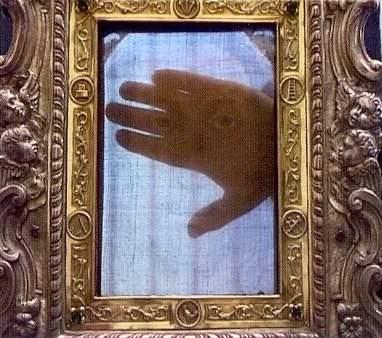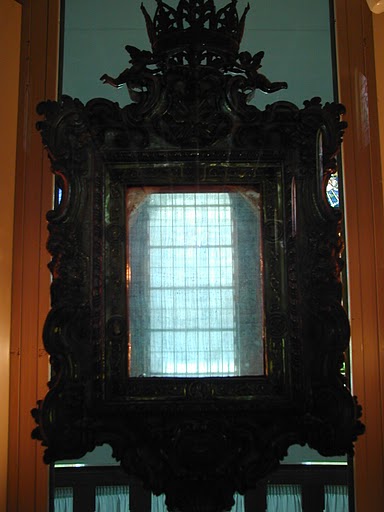|


And on the first day of the week, Mary
Magdalen cometh early, when it was yet dark, unto the sepulchre; and she saw the
stone taken away from the sepulchre.
She ran, therefore, and cometh to Simon Peter, and to the other disciple whom
Jesus loved, and saith to them: They have taken away the Lord out of the
sepulchre, and we know not where they have laid him.
Peter therefore went out, and that other disciple, and they came to the
sepulchre.
And they both ran together, and that other disciple did outrun Peter, and came
first to the sepulchre.
And when he stooped down, he saw the linen cloths lying;
but yet he went not in.
Then cometh Simon Peter, following him, and went into the sepulchre, and
saw the linen cloths lying,
And the napkin that had been about his head, not lying
with the linen cloths, but apart, wrapped up into one place.
Then that other disciple also went in, who came first to the sepulchre: and
he saw, and believed.
For as yet they knew not the scripture, that he must rise again from the dead.
John 20:1–9, Douay-Rheims Bible
Early on the first day of the week, while it was still dark,
Mary Magdalene went to the tomb and saw that the stone had been removed from the
entrance.
So she came running to Simon Peter and the other disciple, the one Jesus loved,
and said, “They have taken the Lord out of the tomb, and we don’t know where
they have put him!”
So Peter and the other disciple started for the tomb.
Both were running, but the other disciple outran Peter and reached the tomb
first.
He bent over and looked in at the strips of linen lying
there but did not go in.
Then Simon Peter, who was behind him, arrived and went into the tomb. He
saw the strips of linen lying there, as well as the burial
cloth that had been around Jesus’ head. The cloth was folded up by itself,
separate from the linen.
Finally the other disciple, who had reached the tomb first, also went inside.
He saw and believed.
(They still did not understand from Scripture that Jesus had to rise from the
dead.)
John 20:1–9, New International Version 1984
Now on the first day of the week Mary Magdalene came early to
the tomb, while it was still dark, and saw the stone already taken away from the
tomb.
So she ran and came to Simon Peter and to the other disciple whom Jesus loved,
and said to them, “They have taken away the Lord out of the tomb, and we do not
know where they have laid Him.”
So Peter and the other disciple went forth, and they were going to the tomb.
The two were running together; and the other disciple ran ahead faster than
Peter and came to the tomb first;
and stooping and looking in, he saw the linen wrappings
lying there; but he did not go in.
And so Simon Peter also came, following him, and entered the tomb; and he
saw the linen wrappings lying there, and the
face-cloth which had been on His head, not lying with the linen wrappings, but
rolled up in a place by itself.
So the other disciple who had first come to the tomb then also entered, and
he saw and believed.
For as yet they did not understand the Scripture, that He must rise again from
the dead.
John 20:1–9, New American Standard Bible

What made John believe? He saw
and believed. If he had seen only bloodstained
burial cloths, he could probably have thought that the Lord's body had been
stolen. But he saw his Rabbi's face. And it must have been the face-cloth which
had been on His head, not lying with the linen wrappings (the shroud, the
sweat cloth or the headbands) but rolled up in a place by itself.
The aforementioned translations come from the
Douay-Rheims Bible, the New International Version and the New American Standard
Bible. Antonio Persili suggests an alternative translation in his treatise "Le
tracce della Risurrezione in Giovanni" ("The traces of the Resurrection
according to John"). The burial cloths, or othonia in Greek, were
lying in keimena position which stands for outspread, intact, not unbound,
undamaged, empty inside. However, the sweat cloths (the Sudarium of Oviedo, the
Holy Cap) were not spread on the grave stone but were lying in another position
as if His head had still been inside. Sister Blandina Paschalis Schlömer
believes that this was caused by blood, sweat and plasma coagulation as well as
aromatic oils and myrrh fixation in the sudaria fabric. This created a crust
which held the shroud fabric where His head had been before. On top there was
the Veil of Manoppello with the image of Resurrected Christ visible against the
white cloth. Therefore Peter and John, the Apostles, saw "outspread bands and
the face-cloth which had been around His head, not outspread with the bands but
just the opposite, wrapped in one position" (John 20:7). Moreover, the Greek
original of the Gospel mentions the horizontal position of the cloths outspread
on the grave stone, yet the words alla choris entetyligmenon describe the
veil still wrapped around where His face had been, in a surprising position i.e.
"raised".
No matter how we interpret the Greek original, John's
behaviour is worth noticing. He was younger than Peter (and the youngest of the
apostles) so he reached the tomb a bit earlier. He stooped (tombs from that
period were usually chambers cut in soft rock to form a hollow below the surface
so in order to enter them one had to bend) but he did not enter the tomb.
According to one hypothesis, he waited for Peter showing respect for his age and
position. Maybe John simply got scared like a human being? However, one cannot
say that he was a coward. He was the only one of the apostles to stay under his
Rabbi's cross, he never denied knowing Him and died of natural causes not like a
martyr. What did he expect when he was running towards the tomb remembering the
words of Mary Magdalene "They have taken away the Lord
out of the tomb, and we do not know where they have laid Him"?
He must have expected to find an empty tomb but what he found stupefied him.
Inside he saw intact burial cloths, arranged in a strange way...

The arrangement of cloths on Friday evening

The arrangement of cloths on Sunday morning
A detailed language analysis reveals one more fact. Greeks
used not fewer than six different words for perception. The word eiden
used in this context means not only the fact of seeing something but also
understanding what one sees. In Polish we sometimes say "reading
comprehension" which is contrasted with thoughtless reading, without
involving one's mind enough. Eiden means "to see and understand what
one has seen". Therefore, having entered the tomb, John saw, understood what
he saw and finally believed in Resurrection.

A slide with the image from Manoppello with a copy of the Sudarium of Oviedo
in the background
Why is there no other mention of the Veil in the Gospels? One
must realise that in those days making any images of God was forbidden by
religious regulations. It was considered a blasphemy and severely punished. That
is why any keepsakes of the Rabbi's passion were thoroughly hidden and stored
with due reverence. The precious Veil of byssus cloth was something completely
exceptional for the followers of Christ. The linen Shroud was also unique
although it did not directly show the image of the Crucified Christ. The
Shroud's true message was discovered not before 1898 when its first negative
photo was taken.
As any relic of this sort, the Veil arouses much controversy.
The majority of disbelievers have not seen the fabric with their own eyes.
However, one may make an effort and look in the eyes of the Person from the Veil.
Personally, I am profoundly impressed.

|